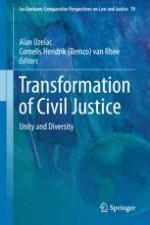2018 | OriginalPaper | Buchkapitel
Human Rights Class Actions
verfasst von : Elisabetta Silvestri
Erschienen in: Transformation of Civil Justice
Aktivieren Sie unsere intelligente Suche, um passende Fachinhalte oder Patente zu finden.
Wählen Sie Textabschnitte aus um mit Künstlicher Intelligenz passenden Patente zu finden. powered by
Markieren Sie Textabschnitte, um KI-gestützt weitere passende Inhalte zu finden. powered by
